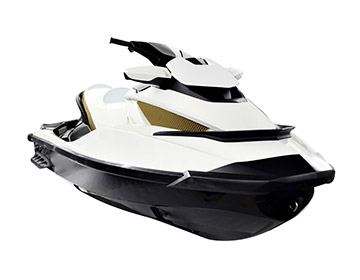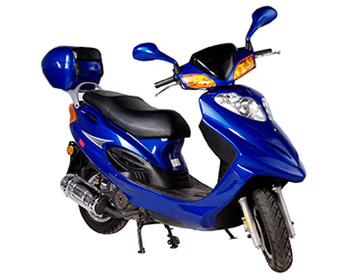HOW TO: Honda ATV Oil Change
Mar 12th 2018
HOW TO: Honda ATV Oil Change

Honda Motor Company is currently the world’s largest manufacturer of internal combustion engines by volume with over 14 million engines produced annually. The Japanese keiretsu, or conglomerate, is famously known for producing automobiles, power equipment, aircraft, powersports vehicles, and even robotics. However, it’s the company’s success with motorcycles and engine production that have earned them the top spot as the world’s largest motorcycle manufacturer; a title they’ve held since 1959. Honda’s all-encompassing range of motorcycles, from dirt bikes to touring cruisers to high-performance sport bikes, has allowed them to best even the most legendary motorcycle marques including Harley-Davidson, Indian, Triumph, BMW, and Ducati, as well as their contemporaries in Yamaha, Suzuki, and Kawasaki. When the Jiger Corporation introduced the world’s first all-terrain vehicle (ATV) in 1965, Honda was one of the first motorcycle manufacturers to attempt to capitalize on its success and stake their claim in this new market.
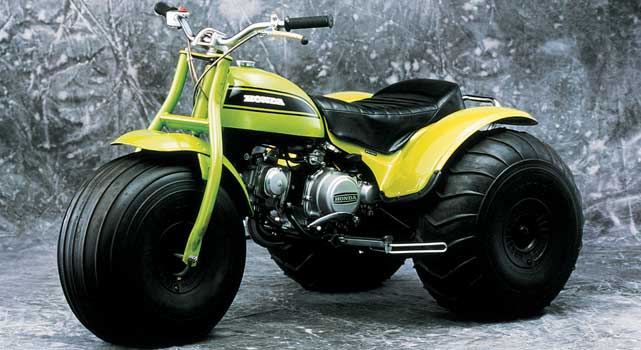
1970 Honda ATC90
In 1970, Honda developed their very first ATV called the ATC90 (originally known as US90). It was a 3-wheeled, motorcycle-based concept that was designed to tackle most any terrain and environment. In 1984, Honda’s first 4-wheel ATV, the TRX200, was released followed by the first 4-wheel drive ATV, the TRX350 FourTrax 4X4, 2 years later. By applying the same spirit of innovation to their ATV series as their motorcycle lineup, Honda became one of the leading names in ATV powersports vehicles and is currently one of the market’s best-selling manufacturers.
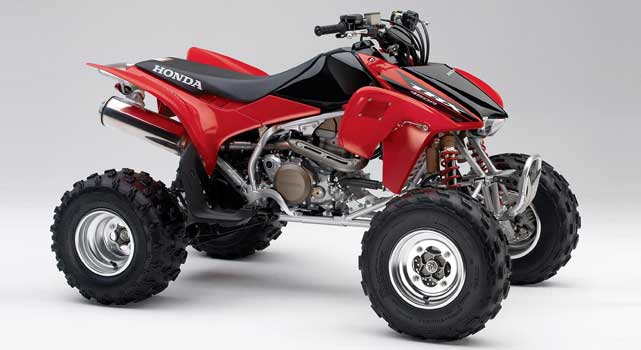
2006 Honda TRX450R
Owners of Honda TRX series ATVs such as the high-performance TRX450R all know that proper maintenance is crucial for long-term reliability. One of the most basic and routine of maintenance tasks is the oil change. Oil is the lifeblood of your engine and regularly-scheduled oil changes, regardless of how often or how little you use your sport ATV, will ensure that your four-wheeler is ready to take on the next off-road adventure or outdoor excursion with ease.
WHAT YOU WILL NEED
- oil drain pan
- shop towels
- chemical-resistant gloves
- plastic oil funnel
- socket wrench
- 8mm socket (oil filter cover)
- 12mm socket (crankcase and oil tank drain plugs)
- 14mm socket (oil tank drain plugs)
- 2 quarts Pro Honda 4-stroke synthetic engine oil (consult owner’s manual)
- cartridge-type oil filter (consult owner’s manual)
The engine in your Honda TRX series ATV may have either a dry-sump or wet-sump type oiling system. In a dry-sump system, the oil reservoir is kept separate from the engine and uses 2 or more pumps to send oil to and from the crankcase. A wet-sump oiling system places the oil reservoir, or oil pan, directly underneath the crankcase and uses only 1 pump. Dry-sump oiling systems are typically used in high-performance or racing applications whereas the conventional wet-sump system is found on most everyday passenger cars, trucks, and motorcycles.
Here, we’ll cover how to change oil in a Honda TRX450R 4-stroke engine that uses a dry-sump oiling system. The directions are the same as changing the oil in a vehicle that uses a wet-sump, but without the additional step of draining the auxiliary oil tank. If you’ve ever changed the oil in your car or truck by yourself, you’ll have no problem changing the oil in your Honda ATV. If you’ve never changed oil yourself and always had someone else do it, here’s a chance for you to learn a simple and important maintenance skill that’ll prolong the life of your sport ATV as well as save you some extra bucks.
STEP 1: GET THE OIL TO TEMPERATURE
Fire the engine and let it idle for about 5 minutes, then shut it off. You always want to change the oil when it’s at temperature. Oil flows freer when it’s hot and this is the most effective way to clear out as much of the old contaminated oil as possible before replacing it with fresh new oil.
STEP 2: DRAINING THE OLD OIL
Place your oil drain pan underneath the engine of your ATV. If your ATV’s engine utilizes a dry-sump oiling system (as in the case of the Honda TRX450R), loosen the dipstick on the oil tank to relieve internal pressure.
- CRANKCASE: Use the 12mm socket to loosen the drain plug on the crankcase. Don’t let the crush washer drop into the drain pan, or else you’ll be fishing it out of there later. Once the oil stops dripping out of the crankcase drain, reinstall the drain plug and tighten to 16 ft. lbs. of torque.
- OIL TANK: On the bottom of the auxiliary oil tank, use the 14mm socket to loosen the drain plug. Again, pay attention and don’t lose the crush washer. Once the oil stops dripping out of the tank, reinstall the drain plug. The torque specification for the oil tank drain plug is 14 ft. lbs.
STEP 3: REPLACE THE OIL FILTER
Move around to the opposite side of the ATV and remove the two 8mm bolts that secure the oil filter cover. There is oil in this compartment, so make sure that your oil drain pan is still underneath the ATV. Once the bolts have been removed, take off the oil filter cover and let the excess oil drain completely. While you have your oil filter cover off, now would be a good time to inspect the o-ring gasket that seals the cover to the engine block. If you notice any visible cracks or wear, replace the o-ring gasket (HQ Powersports sells Winderosa OEM-quality replacement oil seals and complete gasket kits for Honda ATVs, including the TRX450R).
- There is a spring that sits inside the oil filter chamber. You do not need to remove it as it helps position the oil filter. If the spring comes loose or falls out upon removal of the old filter, simply place it back in the same spot where it was.
- The oil filter is directional and must be installed and positioned facing exactly the same way as the old one. The rubber seal on the oil filter needs to face outwards, or else catastrophic engine damage will occur.
- Install the cartridge oil filter into the chamber, line up the cover by way of the bolt holes on the cover itself and on the block. The long bolt goes towards the front of the engine, the short bolt goes towards the rear. Tighten both bolts securely.
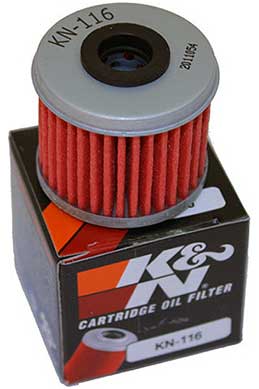
K&N filters aren't just for cars and trucks!
K&N Engineering is, perhaps, the most popular brand in automotive filter technology. Famous in the automotive world for their line of washable cotton gauze air filters and performance cold air intake systems for cars and trucks, K&N also develops a full line of spin-on and cartridge-type oil filters for motorcycles, ATVs, and powersports vehicles. K&N oil filters meet and exceed OEM specifications and are designed and engineered to outperform the stock standard filter, all without voiding the manufacturer’s warranty. K&N filters trap more harmful particulates and contaminants as well as allow for greater capacity flow at higher rates.
At HQ Powersports, we’re proud to be a retailer for K&N Engineering and we stock a full array of replacement K&N cartridge oil filters for ATVs such as the Honda TRX450R.
STEP 4: REFILL
Remove the dipstick (on a dry-sump system, the dipstick will be on the oil reservoir tank) and insert the funnel. The oil capacity for the Honda TRX450R is 1.9 quarts, but you cannot pour in the amount all at once. Instead, gently pour in the first quart, remove the funnel, then reinsert the dipstick. Turn on the engine and have it idle for 15 seconds. This lets the new oil begin to circulate throughout the crankcase and the engine. While the engine is running, visually inspect the drain bolts and oil filter cover bolts for leakage. If leakage is discovered, stop the engine immediately and re-tighten any loose bolts. If no leaks are found, shut the engine off after 15 seconds, remove the dipstick, reinsert the funnel, and pour in the remaining 3/4ths of the second quart of oil. Remove the funnel, reinsert the dipstick, and fire the engine for 3 minutes. After the 3 minutes, shut off the engine and check the dipstick. If the level on the dipstick reads ‘UPPER’, you have properly refilled the oil to the specified capacity.
It’s that simple!





